Scottoro
Chapter 1: First Law in Blues: Intro to the 12 Bar Form
In this chapter you will learn the 12 bar blues progression which is the foundation of the style. You’ll learn to play this simple form with basic dominant 7th chords, a diad riff and move it to several keys.
Tutorial: Intro to the 12 Bar Form In Blues!
In this tutorial we’ll learn the 12 bar form in the context of the blues. Step by step, we will go from playing through the 12 bar form with basic open chords to adding the bluesy dominant 7 chords, a turnaround lick, and much more. After each lesson, we will try out the new “tricks” with an authentic blues backing track.
Introduction: One Progression, Thousands of Songs!
One of the many great things about learning to play blues is that most of the songs have the same chord progression. This progression is called “the 12 bar form” and in this chapter we’ll break down the chords that are used in it and play through the form with a backing track, so you can hear how it sounds in a blues context. This chord progression also shows up in country, funk, rock ‘n’ roll, and many other styles, so by learning this single chord progression you literally learn thousands of songs.
Breaking It Down
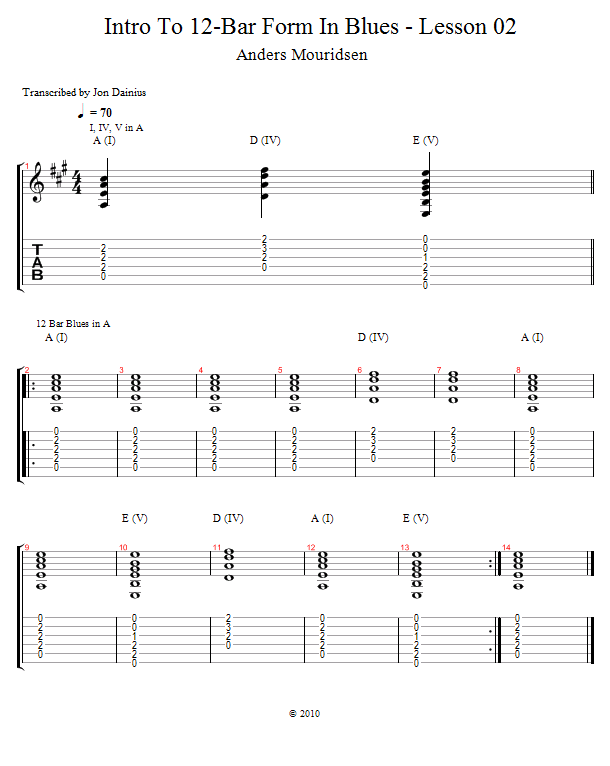
In this lesson, I’ll break down the basic chords and the chord structure of the 12 bar form. Once we’ve practiced it a couple of times, we’re going to play through the 12 bar form with a rockin’ backing track!
Dominant 7 Chords: Key To The Blues

In this lesson we’re going to take a look at a key player in blues harmony: the dominant 7 chord. I’ll show you how the play our I, IV, and V chords as dominant 7 chords, and once you get that down we’ll play through the 12 bar form with the backing track!
Introducing The Turnaround
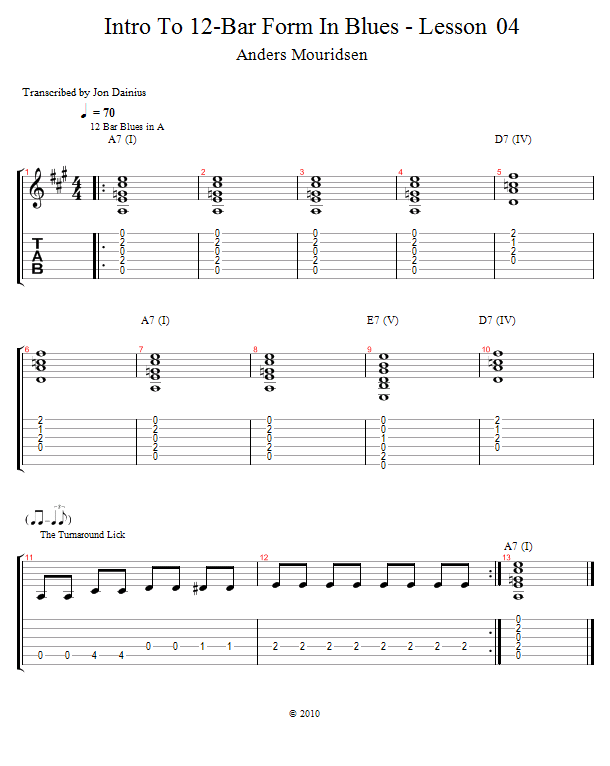
At the end of the 12 bar form we go to the V chord to get ready to start the form all over again. This part is called the “turnaround”, and it’s a great place to show that you really know what’s going on by playing what’s called a “turnaround lick”. In this lesson I’ll show you a very simple example of this, so you can hear how it works!
Adding The V Chord
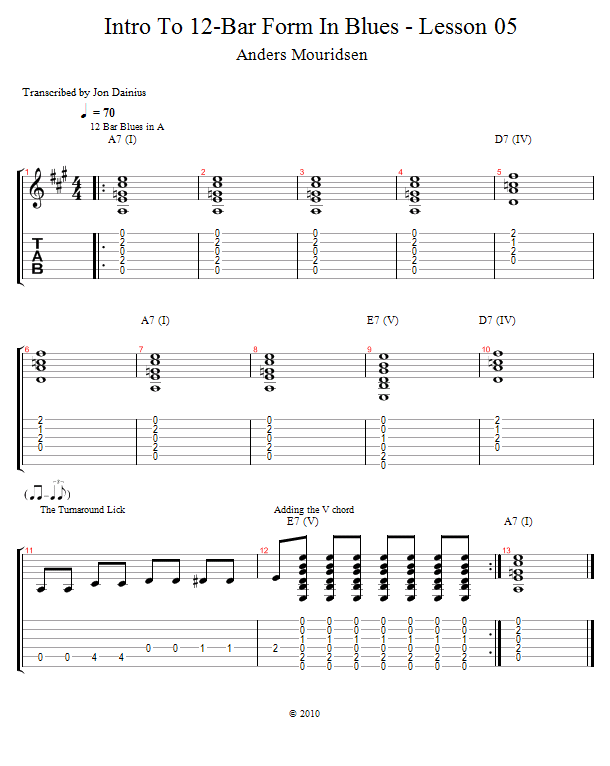
In this lesson we’ll take our turnaround lick one step further by adding strumming of the V chord in bar 12. This builds a lot of tension and gets the listener excited for the “new” 12 bar cycle!
Listen, Play and Learn!
In these lessons you’ve been introduced to the basics of the 12 bar form in blues. The trick is to keep playing and listening to this form until you don’t have to count bars anymore. You need to be able to just “feel” it, so you can just relax and have fun with it. The only way to get there is to listen to a lot of blues while studying it. So listen, play and learn!
Tutorial: Making The 12 Bar Form Sound Like Blues
In this tutorial we are going to break down a classic blues riff. You are probably already familiar with the sound of it, but now you will learn how to play it, how to use it to play through the 12 bar form and how to add a cool “lick” to it.
The Classic Blues Riff
In this next set of lessons I’ll teach you the classic open position blues riff. It sounds hard to play, but it really isn’t; in fact, it was one of the very first things I ever learned to play. Just watch this video and put some time into it. This riff can be used whether you want to sit at home and play the blues or go play it with a band, so it’s time well spent!
Breakin' Down the Classic Blues Riff
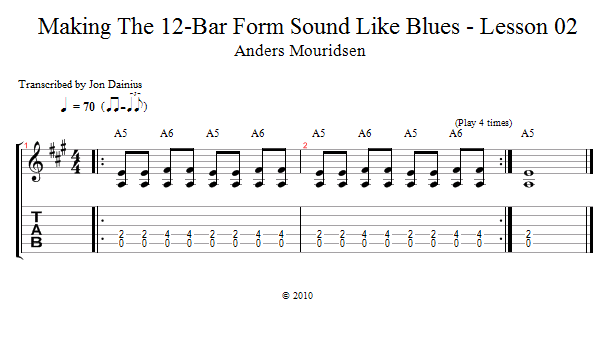
In this lesson I’ll break down the classic blues riff for you. We’ll talk about the left hand muting, right hand picking and finally try it out with a blues backing track!
Classic Blues Riff in the 12 Bar Form

In this lesson we’ll use the blues riff that you learned in the previous lesson to play through the 12 bar form. I’ll show you how to adapt the riff to the IV and the V chord, and once we’ve gone through the whole thing slowly we’ll try it out with the backing track!
Classic Blues Riff with a Lick
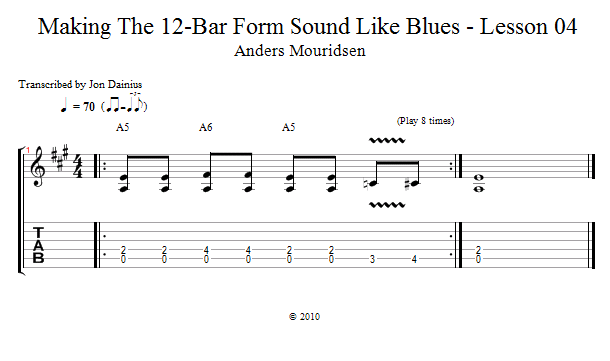
In this lesson we’re going to add a “lick” to the blues riff. The 12 bar form is very simple and is always repeated countless times, so it’s really useful having a couple variations of what you play!
Using the Lick in the 12-bar Form

In this lesson we’re going to play through the 12 bar form with the blues riff and the extra “lick”. You don’t have to play it in every bar like I do; just use it as a variation whenever you feel like it!
Conclusion: Classic Blues Riff
In these lessons you’ve moved a couple of steps closer to being able to play some good basic blues! In the upcoming lessons you’ll learn how to play this riff in other keys, but since many blues songs are in the key of A you’ve already learned to play hundreds of blues songs just by learning the riff in one key!
Tutorial: More 12 Bar Blues Tricks and Keys
In this tutorial we are gonna work on a 12-bar blues progression in the key of E. After breaking down the basic chord structure and chord voicings, we will look at another authentic sounding variation of the blues riff that you learned earlier. After each lesson we will try out the new examples with “the band”…
Introduction: More Blues Tricks and Keys
So far we’ve been playing the 12 bar form in the key of A, and now it’s time to add another typical key to your blues vocabulary. We’re also going to look at more cool variations of the blues riff that you learned earlier!
The Notorious Key Of E
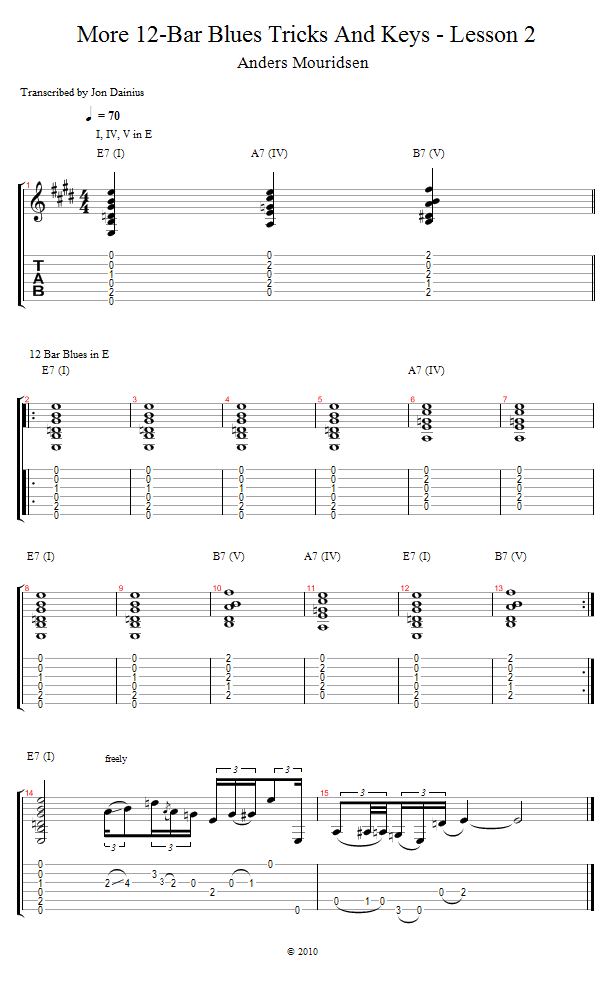
In this lesson I’ll show you how to play a 12 bar blues form in the key of E. Countless blues songs are written in this key, so once again you’re adding hundreds of songs to your vocabulary by learning this. After we’ve broken down the chords, we’ll play through the 12 bar form in the key of E with a blues backing track!
Mixing In Chords With The Blues Riff

In this lesson we’re going to look at a very typical combination of the blues riff that you learned earlier, and the open chords that we covered in the previous lesson.
Later you’ll learn how to play the blues riff in any key, but for now we’ll use the blues riff for the I and IV chord, and the open B7 voicing for the V chord. This is something you hear guys like Freddie King, Stevie Ray Vaughan, and Eric Clapton do often.
Another Cool Variation Of The Blues Riff

In this lesson we’re going to look at another authentic and very useful variation of the blues riff that you learned earlier. After we have broken it down, we are gonna try it out with the backing track.
Play the 12 Bar Form with the New Blues Riff

In this lesson we’ll be using the variation of the blues riff that you learned in the previous lesson to play through the 12 bar form in E. I’ll break it down for you, and then we’ll try it out with the backing track!
Conclusion: Take Your Time!
At this point you’re probably feeling your blues vocabulary growing lesson by lesson. Make sure to take the time to get comfortable with the material before moving on. The practice time you get while watching the videos is not enough. Think of how you would study with a private instructor; you would be introduced to a new concept and then have a week or so to practice it!
Because the more comfortable you are with something like this, the more you can just relax and have fun while playing, and that’s what it’s all about: working hard now, so you can jam and be great later!